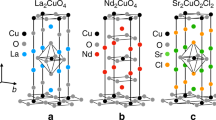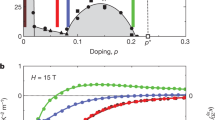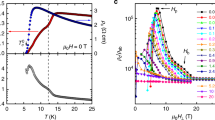Abstract
Among the most actively studied issues in the cuprates are the natures of the pseudogap and strange metal states and their relationship to superconductivity1. There is general agreement that the low-energy physics of the Mott-insulating parent state is well captured by a two-dimensional spin S = 1/2 antiferromagnetic Heisenberg model2. However, recent observations of a large thermal Hall conductivity in several parent cuprates appear to defy this simple model and suggest proximity to a magneto-chiral state that breaks all mirror planes that are perpendicular to the CuO2 layers3,4,5,6. Here we use optical second harmonic generation to directly resolve the point group symmetries of the model parent cuprate Sr2CuO2Cl2. We report evidence of an order parameter that breaks all perpendicular mirror planes and is consistent with a magneto-chiral state in zero magnetic field. Although this order is clearly coupled to the antiferromagnetism, we are unable to realize its time-reversed partner by thermal cycling through the antiferromagnetic transition temperature or by sampling different spatial locations. This suggests that the order onsets above the Néel temperature and may be relevant to the mechanism of pseudogap formation.
This is a preview of subscription content, access via your institution
Access options
Access Nature and 54 other Nature Portfolio journals
Get Nature+, our best-value online-access subscription
$29.99 / 30 days
cancel any time
Subscribe to this journal
Receive 12 print issues and online access
$209.00 per year
only $17.42 per issue
Buy this article
- Purchase on Springer Link
- Instant access to full article PDF
Prices may be subject to local taxes which are calculated during checkout




Similar content being viewed by others
Data availability
Source data are provided with this paper. All other data that support the plots within this paper and other findings of this study are available from the corresponding author upon reasonable request.
References
Keimer, B., Kivelson, S. A., Norman, M. R., Uchida, S. & Zaanen, J. From quantum matter to high-temperature superconductivity in copper oxides. Nature 518, 179–186 (2015).
Lee, P. A., Nagaosa, N. & Wen, X.-G. Doping a Mott insulator: physics of high-temperature superconductivity. Rev. Mod. Phys. 78, 17–85 (2006).
Grissonnanche, G. et al. Giant thermal Hall conductivity in the pseudogap phase of cuprate superconductors. Nature 571, 376–380 (2019).
Boulanger, Marie-Eve et al. Thermal Hall conductivity in the cuprate Mott insulators Nd2CuO4 and Sr2CuO2Cl2. Nat. Commun. 11, 5325 (2020).
Han, J. H., Park, J.-H. & Lee, P. A. Consideration of thermal Hall effect in undoped cuprates. Phys. Rev. B 99, 205157 (2019).
Samajdar, R., Chatterjee, S., Sachdev, S. & Scheurer, M. S. Thermal Hall effect in square-lattice spin liquids: a Schwinger boson mean-field study. Phys. Rev. B 99, 165126 (2019).
Grande, B. & Müller-Buschbaum, H. über erdalkalimetalloxocuprate, VIII Zur Kenntnis von Sr2CuO2Cl2. Z. Anorg. Allg. Chem. 417, 68–74 (1975).
Miller, L. L. et al. Synthesis, structure, and properties of Sr2CuO2Cl2. Phys. Rev. B 41, 1921–1925 (1990).
Cuccoli, A., Roscilde, T., Vaia, R. & Verrucchi, P. Detection of XY behavior in weakly anisotropic quantum antiferromagnets on the square lattice. Phys. Rev. Lett. 90, 167205 (2003).
Suh, B. J. et al. Evidence for crossover effects in the spin dynamics of the two dimensional antiferromagnet Sr2CuO2Cl2 from 35Cl nuclear magnetic resonance. J. Appl. Phys. 79, 5084–5086 (1996).
Katsumata, K. et al. Direct observation of the quantum energy gap in S = 1/2 tetragonal cuprate antiferromagnets. Europhys. Lett. 54, 508–514 (2001).
Greven, M. et al. Neutron scattering study of the two-dimensional spin S = 1/2 square-lattice Heisenberg antiferromagnet Sr2CuO2Cl2. Z. Phys. B 96, 465–477 (1995).
Fiebig, M., Pavlov, V. V. & Pisarev, R. V. Second-harmonic generation as a tool for studying electronic and magnetic structures of crystals: review. J. Opt. Soc. Am. B 22, 96–118 (2005).
Harter, J. W., Niu, L., Woss, A. J. & Hsieh, D. High-speed measurement of rotational anisotropy nonlinear optical harmonic generation using position-sensitive detection. Opt. Lett. 40, 4671–4674 (2015).
Choi, H. S. et al. Anomalous temperature dependence of charge-transfer excitation in the undoped cuprate Sr2CuO2Cl2. Phys. Rev. B 60, 4646–4652 (1999).
Vaknin, D., Sinha, S. K., Stassis, C., Miller, L. L. & Johnston, D. C. Antiferromagnetism in Sr2CuO2Cl2. Phys. Rev. B 41, 1926–1933 (1990).
Ye, F. et al. Structure symmetry determination and magnetic evolution in Sr2Ir1−xRhxO4. Phys. Rev. B 92, 201112(R) (2015).
Farzaneh, M., Liu, X. F., El-Batanouny, M. & Chou, F. C. Structure and lattice dynamics of Sr2CuO2Cl2(001) studied by helium-atom scattering. Phys. Rev. B 72, 085409 (2005).
Dürr, C. et al. Angle-resolved photoemission spectroscopy of Sr2CuO2Cl2. Phys. Rev. B 63, 014505 (2000).
Ron, A., Zoghlin, E., Balents, L., Wilson, S. D. & Hsieh, D. Dimensional crossover in a layered ferromagnet detected by spin correlation driven distortions. Nat. Commun. 10, 1654 (2019).
De Luca, G. M. et al. Weak magnetism in insulating and superconducting cuprates. Phys. Rev. B 82, 214504 (2010).
Fiebig, M., Fröhlich, D., Sluyterman, v. L. G. & Pisarev, R. V. Domain topography of antiferromagnetic Cr2O3 by second harmonic generation. Appl. Phys. Lett. 66, 2906–2908 (1995).
Fechner, M., Fierz, M. J. A., Thöle, F., Staub, U. & Spaldin, N. A. Quasistatic magnetoelectric multipoles as order parameter for pseudogap phase in cuprate superconductors. Phys. Rev. B 93, 174419 (2016).
Varma, C. Non-Fermi-liquid states and pairing instability of a general model of copper oxide metals. Phys. Rev. B 55, 14554–14580 (1997).
Aji, V., Shekhter, A. & Varma, C. M. Theory of the coupling of quantum-critical fluctuations to fermions and d-wave superconductivity in cuprates. Phys. Rev. B 81, 064515 (2010).
He, Y., Lee, P. A. & Varma, C. M. Intrinsic anomalous Hall effect in magnetochiral states. Phys. Rev. B 89, 035119 (2014).
Scheurer, M. S. & Sachdev, S. Orbital currents in insulating and doped antiferromagnets. Phys. Rev. B 98, 235126 (2018).
Sachdev, S. Colloquium: order and quantum phase transitions in the cuprate superconductors. Rev. Mod. Phys. 75, 913–932 (2003).
Dai, Z., Senthil, T. & Lee, P. A. Modeling the pseudogap metallic state in cuprates: quantum disordered pair density wave. Phys. Rev. B 101, 064502 (2020).
Wang, X. L. et al. Antiferromagnetic form factor of Sr2CuO2Cl2. J. Appl. Phys. 67, 4524–4526 (1990).
Guarise, M. et al. Measurement of magnetic excitations in the two-dimensional antiferromagnetic Sr2CuO2Cl2 insulator using resonant X-ray scattering: evidence for extended interactions. Phys. Rev. Lett. 105, 157006 (2010).
Plumb, K. W., Savici, A. T., Granroth, G. E., Chou, F. C. & Kim, Y.-J. High-energy continuum of magnetic excitations in the two-dimensional quantum antiferromagnet Sr2CuO2Cl2. Phys. Rev. B 89, 180410 (2014).
Seemann, M., Ködderitzsch, D., Wimmer, S. & Ebert, H. Symmetry-imposed shape of linear response tensors. Phys. Rev. B 92, 155138 (2015).
Lubashevsky, Y., Pan, L., Kirzhner, T., Koren, G. & Armitage, N. P. Optical birefringence and dichroism of cuprate superconductors in the THz regime. Phys. Rev. Lett. 112, 147001 (2014).
Zhao, L. et al. A global inversion-symmetry-broken phase inside the pseudogap region of YBa2Cu3Oy. Nat. Phys. 13, 250–254 (2017).
Mukherjee, A. et al. Linear dichroism infrared resonance in overdoped, underdoped, and optimally doped cuprate superconductors. Phys. Rev. B 102, 054520 (2020).
Fauqué, B. et al. Magnetic order in the pseudogap phase of high-TC superconductors. Phys. Rev. Lett. 96, 197001 (2006).
Tang, Y. et al. Orientation of the intra-unit-cell magnetic moment in the high-Tc superconductor HgBa2Cuo4+δ. Phys. Rev. B 98, 214418 (2018).
Xia, J. et al. Polar Kerr-effect measurements of the high-temperature YBa2Cu3O6+x superconductor: evidence for broken symmetry near the pseudogap temperature. Phys. Rev. Lett. 100, 127002 (2008).
Perkins, J. D. et al. Mid-infrared optical absorption in undoped lamellar copper oxides. Phys. Rev. Lett. 71, 1621–1624 (1993).
Acknowledgements
We acknowledge helpful conversations with D. Kennes, S. Kivelson, P. Lee, O. Motrunich, D. Pelc and K. Plumb. We also thank L. Taillefer and G. Grissonnanche for sharing unpublished data. The SHG work is supported by an ARO PECASE award W911NF-17-1-0204. D.H. also acknowledges support for instrumentation from the David and Lucile Packard Foundation and from the Institute for Quantum Information and Matter (IQIM), an NSF Physics Frontiers Center (PHY-1733907). A.d.l.T. acknowledges support from the Swiss National Science Foundation through an Early Postdoc Mobility Fellowship (P2GEP2_165044). K.L.S. acknowledges a Caltech Prize Postdoctoral Fellowship. S.S. acknowledges support from NSF grant DMR-2002850. M.S.S. acknowledges support from the German National Academy of Sciences Leopoldina through Grant LPDS 2016-12. M.R.N. was supported by the Materials Sciences and Engineering Division, Basic Energy Sciences, Office of Science, US Department of Energy. The work at the University of Minnesota was funded by the US Department of Energy through the University of Minnesota Center for Quantum Materials, under grant no. DE-SC-0016371.
Author information
Authors and Affiliations
Contributions
A.d.l.T., L.Z., D.H. and M.G. conceived the experiment. A.d.l.T., K.L.S. and L.Z. performed the optical measurements. Y.L. and B.Y. synthesized, characterized and aligned the samples. A.d.l.T., L.Z. and D.H. analysed the data. S.D.M., M.S.S., S.S. and M.R.N. performed the theoretical calculations and, together with A.d.l.T. and D.H., interpreted the results. A.d.l.T. and D.H. wrote the manuscript with input from all authors.
Corresponding author
Ethics declarations
Competing interests
The authors declare no competing interests.
Additional information
Peer review information Nature Physics thanks Manfred Fiebig and Marco Grioni for their contribution to the peer review of this work.
Publisher’s note Springer Nature remains neutral with regard to jurisdictional claims in published maps and institutional affiliations.
Supplementary information
Supplementary Information
Supplementary Figs. 1–9 and Sections 1–12.
Source data
Source Data Fig. 2
RA-SHG data.
Source Data Fig. 3
Single angle temperature dependence data.
Rights and permissions
About this article
Cite this article
Torre, A.d.l., Seyler, K.L., Zhao, L. et al. Mirror symmetry breaking in a model insulating cuprate. Nat. Phys. 17, 777–781 (2021). https://doi.org/10.1038/s41567-021-01210-6
Received:
Accepted:
Published:
Issue Date:
DOI: https://doi.org/10.1038/s41567-021-01210-6



